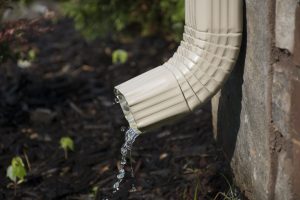It depends.
On paper, when they’re maintained and properly cared for, rain gutters can last for at least 20 years. But in addition to proper care and maintenance, there are other factors that play a role in gutter longevity. One is the gutter material. Vinyl, for instance, is a less durable gutter material than steel and aluminum, hence it’s also likely to require replacement sooner – especially in areas that experience significant weather. 
In this post, we’ll get into why gutters are so important, how to ensure gutter longevity and when to know it’s time to replace your gutters.
Why Are Gutters So Important?
When they’re working properly, gutters play a significant role in preventing water intrusion and foundation degradation to your property.
Simply put, gutters are designed to safely disperse rain runoff and snow melt away from your property so that it’s not pooling or puddling up around your foundation. When this occurs, so too does the potential for water intrusion. If even a small amount of water enters your property, it can lead to significant water damage in the lower levels of your home. Water damage restoration is costly and can also lead to subsequent problems such as mold growth.
Ideally, your gutter system is free flowing and downspouts are positioned so that water is draining away from your home and not toward it. If your gutters are obstructed, then water is likely to fill and pour over directly onto the ground beneath them, which can result in foundation problems. The excess weight can also cause the gutters to sag and pull away from the home. And if downspouts are not positioned properly, then they’ll likely lead to water pooling around the foundation and not safely draining away from it. This, too, can lead to significant issues.
Tips to Ensure Gutter Longevity
So what can be done to ensure gutter longevity? There are many things that you should take into consideration to ensure that your gutters are in good working condition and drain roof runoff properly. Here’s a look:
Clean Them Regularly
You should clean your gutters at least twice a year, more if you live in areas of dense foliage. When leaves, twigs and other debris fall onto your roof, they’re eventually going to make their way into your gutters. When this happens, they can clog downspouts and prevent water from freely draining. Furthermore, the buildup of water and other debris can add significant weight to the gutters, causing them to sag and/or pull away from the roof line. Cleaning the gutters out can help prevent this.
If you don’t like cleaning your gutters, consider investing in gutter guards. These fit directly over the top of your gutters and prevent larger debris from entering your gutters, while still allowing water to easily pass through. Think of them as a gutter filter. Gutter guards can be especially helpful in areas with dense tree cover.
Monitor for Leaks
Gutters take a beating, so over time it’s not uncommon for them to develop leaks – especially around seams where the seal may be a bit more compromised. That said, you should periodically check for leaks and repair them when necessary. It’s fairly simple to do.
The next time it rains, just grab an umbrella and head outside. Walk the perimeter of your home and pay attention to your gutters. Are they freely draining, or are there parts in the system that are leaking? Make sure to repair any leaks to avoid water intrusion issues around your home and prevent small issues from becoming bigger ones.
Trim Back Landscaping
Trees, bushes and other landscaping that may come into contact with your gutters are something you’ll also want to keep an eye on. This is especially true in the winter time, when ice and snowfall can add significant weight to tree branches that may scrape and damage your gutters.
It’s always a good idea to ensure that any trees are properly trimmed so that they do not come into contact with any part of the home. This is best carried out in the fall before the winter months set in.
Be Wary of Ice Dams
Ice dams form when snow melt from the roof refreezes around the roof line or in the gutters during the winter months. When this happens, it can prevent the proper flow of water and potentially even lead to water intrusion into the attic.
There are a few ways to prevent ice dams. One, make sure that your gutters are free of debris so that any runoff can drain freely. Two, you may want to invest in a roof rake, a rake that’s designed specifically for working on the roof of your home. Use it following a significant snowfall to remove snow from the roofline of your home so that water can drain more freely.
Ice dams can add weight to gutters and cause significant damage should they form. Be weary of them during the winter months and take action when necessary.
How to Know When It’s Time to Replace Your Gutters
So let’s bring this post full circle and discuss how to know when it’s time to replace your gutters. Aside from old age, there are a few signs to watch out for:
- Are they damaged to the point where it would be easier to replace them than repair them?
- Are nails or fasteners that hold the gutters in place becoming worn?
- Are the gutters sagging or pulling away from your home?
- Are the gutters bent, dented or damaged?
- Are your gutters no longer sloped appropriately to permit water to drain?
Contact K-Guard
For more information on when it’s time to replace your gutters, contact K-Guard today.
This post first appeared on https://www.kguard.com